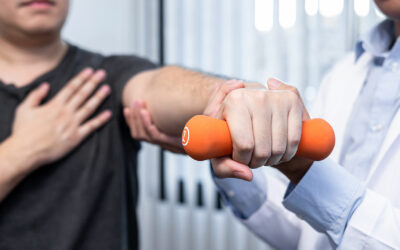Have you ever faked your way through a fitness class because you had no idea what the instructor was talking about? Anaerobic, AMRAP, intervals, circuits, super sets – sometimes the language of fitness is more confusing than it should be.
There are many terms within the fitness world that you may not yet understand, but once you do, they make perfect sense. Let’s waste no time and jump into a few of our favorites to get you started.
CIRCUITS
A circuit is a collection of exercises completed back-to-back-to-back. The positive effect that circuit training has on strength is proven, and used creatively, they can make a boring workout much more interesting. Let’s say you’re in an exercise class and your instructor wants to increase your heart rate. She may create a circuit of 20 jumping jacks, followed immediately by 10 burpees, immediately followed by 15 air squats. You do these three movements without a break in between – but you do get rest after all three. Then you start again and do it as much as the instructor demands of you.
BURPEES
Since we mentioned burpees, let’s explain what exactly they are. Burpees are an excellent conditioning exercise that activates several muscle groups, including your legs, chest, arms, and core. (Here is a fantastic visual on how to do them correctly.) It’s basically an intense push-up, but you begin and end in the standing position.
Burpees are commonly lauded and despised by exercisers across the globe. They are not easy – but they make any fitness circuit so much more challenging.
INTERVALS
Interval workouts are designed to alternate between exertion and rest, and can be tailored to any fitness discipline: weightlifting, running, swimming, CrossFit, and on and on. If you’re a distance runner, you may want to mix up your 10-mile-plus workouts with interval days; run a mile at 90% effort, jog a half mile at 50%, run a mile at 90%, jog a half mile at 50%, etc. Clearly, your trainer or PT can help you dial-in the best interval workouts to help you hit your fitness goals.
Recently, popular parlance seems to refer to common interval training workouts as HIIT (pronounced: “hit”), which stands for high intensity interval training. HIIT refers to the short bursts of intense exercise alternated with low-intensity recovery periods. This might sound intimidating, but interval training isn’t just for athletes in their prime. In fact, seniors perhaps have more to gain from some HIIT as well.
RANGE OF MOTION
Stick your arm out straight with your palm facing to the ceiling, then bend your elbow and touch your shoulder. This is an example of range of motion. All of your joints have a range of motion; in other words, the amount that you can move a joint from full extension to full flexion (straight to bent).
Studies show that performing exercises with a full range of motion are beneficial and motions that stop short of their full potential are less so. If you are an experienced gym-goer, you have undoubtedly noticed two common exercises that people get wrong: squats and bicep curls. Novice weightlifters can easily become focused on how much weight they lift instead of how they lift the appropriate amount of weight. This leads to a person stacking heavy weights on a bar even though they can’t move that weight in the full range of motion it takes to be most effective. (Case in point: if you are squatting with a free bar or a Smith machine, your thighs MUST be parallel to the ground before you activate and stand up. Novice lifters often stand before they reach parallel – which often happens when they add too much weight!)
AEROBIC/ANAEROBIC
The difference between aerobic and anaerobic is one of the more confusing concepts in the world of fitness. Aerobic exercise is any exercise categorized as cardiovascular in nature (aka cardio), while anaerobic exercise utilizes short bursts of exertion at high levels of effort. Aerobic exercise is anything similar to running, biking, swimming, etc, while anaerobic exercises include weightlifting, resistance training, jumping, gymnastics, etc. Think of it this way: aero is the root of aerobic, and it indicates that air (oxygen) is involved in the process. Anaerobic starts with the prefix ‘an-’, which indicates the opposite of that. Aerobic exercise increases the oxygen in your blood that flows to your muscles for sustained muscle exertion. Anaerobic exercise is less reliant on oxygen and instead uses stored carbs and glucose in your body to ignite your inertia.
Both types of exercise tax your body differently, but both are excellent ways to exercise. In general, aerobic exercise is more beginner-friendly, since all you need is the will to get outside and walk or jog. It’s a good idea to make sure you build this fitness base before you start adding in weight training or HIIT concepts into your daily routine.
SETS & REPS
Generally, you’ll only hear the terms sets and reps in a gym where people are lifting weights or using weight machines. A rep is short for repetition – one full lift of a weight in a particular motion. A set is a group of repetitions completed without releasing the weight.
In other words, if someone says they are training their biceps and they did 3×10 bicep curls, they are indicating that they did 3 full sets of 10 total reps – or 30 reps broken down into 3 groups of 10. You don’t always have you do 3 sets of 10 reps, however; there are multiple approaches you can take depending on if you are trying to increase muscle strength, grow muscle mass, or improve muscle endurance. You can adjust your sets and reps depending on the amount of weight you’re lifting as well.
In fact, you can add a ton of variety to the way you count your sets and reps to make your workout a lot more exciting. AMRAP is an acronym that stands for As Many Rounds (or Reps) As Possible in a given amount of time. Let’s say you’re doing a pre-determined circuit: instead of doing 3 rounds, you may give yourself a 5-minute limit to see how many rounds you can get in that amount of time. It’s a nice little spice to throw into a dish you’ve had time after time. Or consider a superset, which is when you alternate sets of two different movements, like a bicep curl and a tricep extension. Instead of doing 10 reps of a bicep curl and resting, you do 10 reps of a bicep curl and then immediately go into 10 reps of a tricep extension without resting. Since the second movement is different from the bicep curl, your bicep muscles get a chance to recover while you work your triceps.
Exercise is an experiential endeavor. You don’t need to know the meaning of every term or understand every acronym to lace up a pair of sneakers and get moving. If you are struggling to understand how to do certain movements, or if you are unsure if you are ready for a certain activity, give us a call and learn what our expert physical therapists can do for you!



